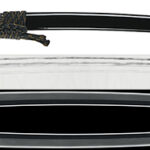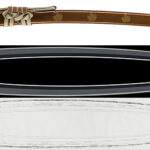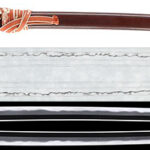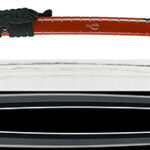Ordering number:AS24526
Katana in Shirasaya (5th NBTHK Tokubetsu Juyo Token)
Signature: Mumei (attributed to Taima)
無銘(当麻
We divide 4 sections for each sword as Saijyo Saku, Jyojyo Saku, Jyo Saku, and Regular Saku. This piece is ranked as Saijyo Saku (top grade) for Mumei (attributed to Taima).
Habaki: Gold-covered double-layered habaki
Blade length: 2 shaku 2 sun 4 bu 5 rin (68.03 cm / 26.77 in) Curvature: 5 bu 5 rin (1.67 cm / 0.66 in)
Mekugi holes: 2
Width at base (Motohaba): 2.8 cm (1.10 in)
Width at tip (Sakihaba): 2.02 cm (0.79 in)
Thickness (Kasane): 0.7 cm (0.28 in)
Sword weight: 705 grams (1.55 lbs)
Era: Late Kamakura Period
Shape: This piece has a ō-suriage (greatly shortened) mumei style with a well-proportioned, wide blade and deep curvature. The tip is extended, giving it a well-balanced and elegant appearance.
Jigane: The forging pattern is an exquisite mix of itame-hada and mokume-hada, with prominent chikei visible. The jihada is well-forged and displays the highest level of craftsmanship, with rich nie grains.
Hamon: The hamon is a suguha base with vigorous ashi, vibrant ha activity, prominent kinsuji, and a mix of sunagashi. The boshi shows a midare pattern with a sweeping kaeri (return).
Features: The Taima school, founded in the mid-Kamakura period, is closely associated with the Taima Temple in Nara. The Taima smiths, believed to have served the temple, produced many unsigned works. Signed pieces by Kuniyuki, the school's founder, exhibit a well-forged itame base, a calm suguha hamon with nie grains, and gentle sunagashi. However, many works from the Taima school, including this one, display a bolder, more intense style reminiscent of the Soshu tradition, with strong nie and prominent kinsuji.
Aoi Art's Comment: This sword is a Tokubetsu Juyo Token, certified in the 5th session (December 7, 1976) with exceptional speed. It fully demonstrates the beauty of the Soshu tradition, leaving viewers deeply moved. The description of this sword notes its vibrant activity within the hamon, a characteristic seen in many Taima works. In contrast to other local smiths such as Tegai, Shikkake, and Hosho, the Taima school excels in chikei visibility and strong nie. This piece is highly recommended.
5th NBTHK Tokubetsu Juyo Token
Aoi Art estimation paper
Whole Oshigata
Auction Starting Price:13,000,000JPY
Place Bid
Related Items:
 Katana:Mumei (attributed to Den Hosho).(NBTHK Tokubetsu Hozon Token)
Katana:Mumei (attributed to Den Hosho).(NBTHK Tokubetsu Hozon Token)
 Katana: Nobutsugu(Aoe)(65th NBTHK Juyo Token)
Katana: Nobutsugu(Aoe)(65th NBTHK Juyo Token)
 Katana:Signature: Mumei (attributed to Den Cho Aritoshi)(25th NBTHK Juyo Token)
Katana:Signature: Mumei (attributed to Den Cho Aritoshi)(25th NBTHK Juyo Token)
 Katana: Hizen Kuni Kawachi Daijo Masahiro (first generation)(61st NBTHK Juyo Paper)
Katana: Hizen Kuni Kawachi Daijo Masahiro (first generation)(61st NBTHK Juyo Paper)
 Katana: Mumei (attributed to Aoe)(21st NBTHK Juyo Token)
Katana: Mumei (attributed to Aoe)(21st NBTHK Juyo Token)
 Katana: Mumei (attributed to Den Rai Kunitoshi)(NBTHK 37th Juyo Token)
Katana: Mumei (attributed to Den Rai Kunitoshi)(NBTHK 37th Juyo Token)






